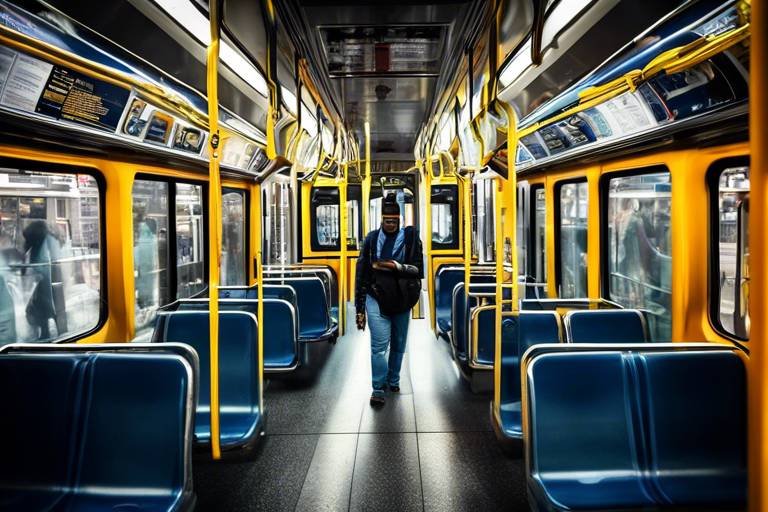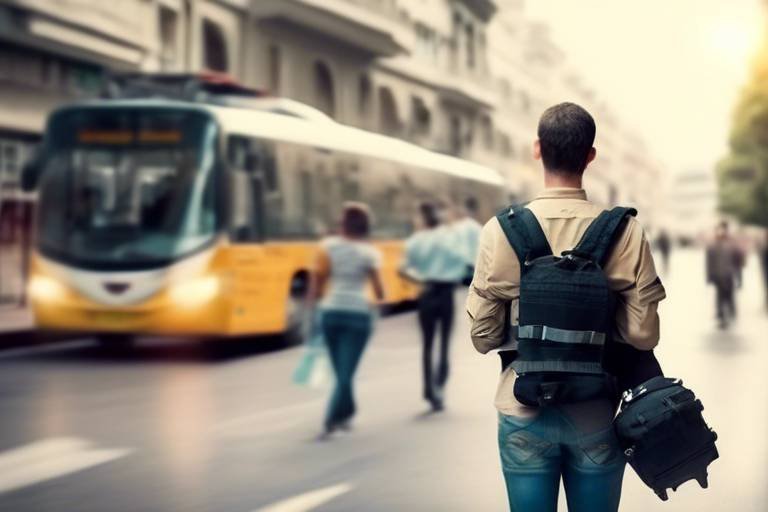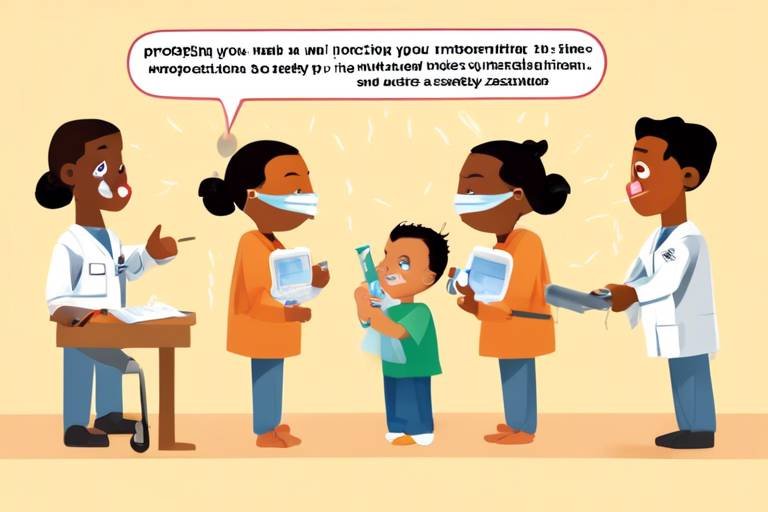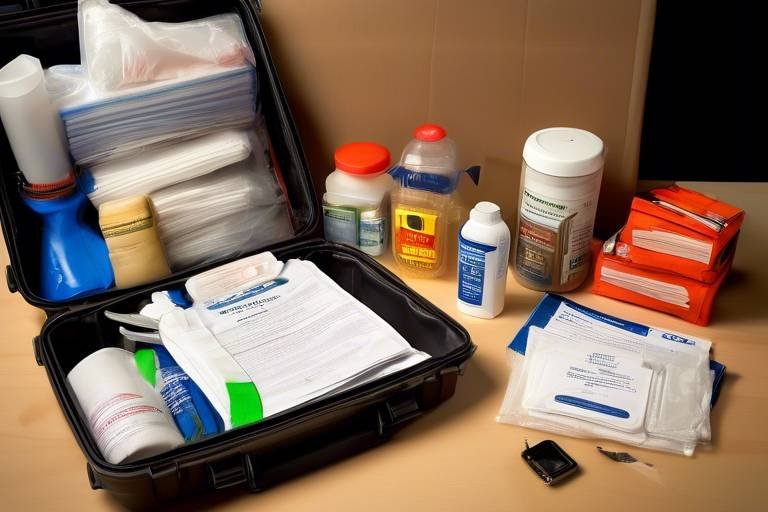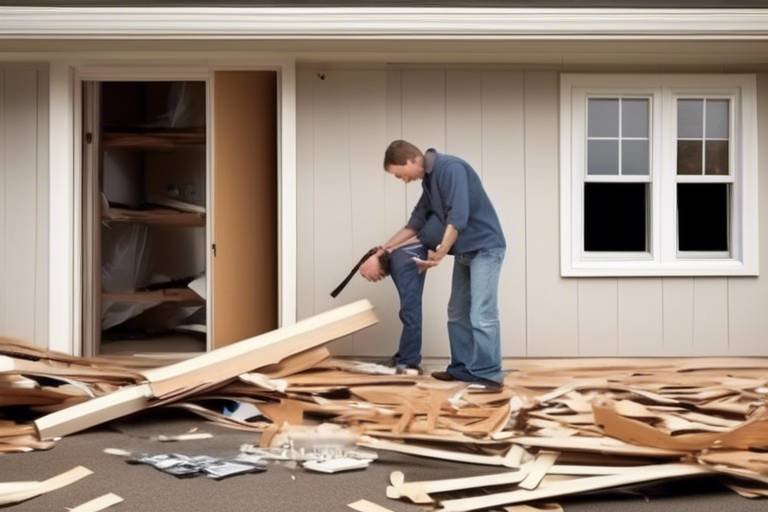Navigating Safety as a First-Time Parent
Becoming a parent for the first time is like stepping into a whirlwind of emotions, excitement, and yes, a sprinkle of anxiety. You want to provide the best for your little one, but the sheer amount of information out there can be overwhelming. Safety is often at the forefront of every new parent's mind, and rightly so! After all, you want to create a secure environment where your child can explore, learn, and grow without unnecessary risks. In this article, we’ll dive deep into essential safety tips and practices that will help you navigate this new journey with confidence.
Think of your home as a sanctuary for your baby. It's not just about keeping them safe from immediate dangers but also about fostering a space where they can thrive. From baby-proofing your living space to understanding the ins and outs of car safety, each step you take brings you closer to peace of mind. So, grab a cup of coffee, take a deep breath, and let’s embark on this adventure together!
Creating a safe living space is vital for new parents. Imagine your home as a playground for your little explorer. Every corner can be a potential hazard if you’re not careful. Start by securing heavy furniture to the walls to prevent tipping, especially in areas where your baby might crawl or pull themselves up. Covering outlets with safety plugs is a must; those tiny fingers are naturally curious! Additionally, think about removing hazardous items like cleaning supplies and sharp objects from reach. It’s amazing how a little foresight can prevent accidents.
When it comes to transporting your baby, understanding car safety is crucial. You wouldn’t drive without buckling your seatbelt, right? The same goes for your child! Proper car seat installation is key. Make sure you select a seat that’s appropriate for your child’s age and size. Did you know that many local fire departments or hospitals offer free car seat checks? It’s worth taking advantage of these resources to ensure you’re doing it right!
Establishing safe sleep habits can prevent Sudden Infant Death Syndrome (SIDS). It’s heart-wrenching to think about, but creating a safe sleep environment is essential. Always place your baby on their back to sleep and use a firm mattress with a fitted sheet in the crib. Avoid soft bedding, pillows, and toys in the crib to minimize risks. Keeping the room at a comfortable temperature can also help your baby sleep soundly and safely.
Being prepared for emergencies can save lives. It’s not about living in fear but rather about having a plan. Consider creating an emergency plan that includes escape routes and emergency contacts. Assemble a first aid kit stocked with essentials like band-aids, antiseptic wipes, and infant medications. Additionally, familiarize yourself with common household emergencies, such as choking or burns, and know how to respond. This knowledge can be a game-changer!
Selecting age-appropriate and non-toxic toys is crucial for your child's safety. Toys are more than just playthings; they’re tools for development. When evaluating toys, look for safety standards and avoid those with small parts that could pose choking hazards. Regular toy inspections are also important to ensure they remain safe and functional. Remember, a toy that’s safe today might not be safe tomorrow!
Maintaining your child’s health starts with proper hygiene. Simple practices like handwashing can prevent the spread of germs. Make it a habit to wash your hands before handling your baby, especially after changing diapers. Vaccinations are another crucial part of keeping your child healthy, so stay on top of their immunization schedule. Lastly, learn to recognize signs of illness early on; your intuition as a parent is invaluable!
Constant supervision is key to keeping your child safe. It’s easy to get distracted, but your little one is always exploring! Use baby monitors to keep an eye on them when you’re in another room, and know when to intervene to prevent accidents. Remember, being present isn’t just about watching; it’s about engaging with your child and understanding their needs.
Navigating the array of childproofing products can be overwhelming. From cabinet locks to corner guards, the options are endless. Not all products are created equal, so it’s essential to research their effectiveness. Choose products that fit your specific home environment and lifestyle. A well-childproofed home can provide you with the confidence to let your child explore safely!
Utilizing community resources can enhance safety knowledge. Local parenting classes and support groups can be invaluable for first-time parents. Not only do they provide practical knowledge, but they also offer a space to connect with others who are navigating the same challenges. Online resources can also be a treasure trove of information, so don’t hesitate to reach out for help!
- What are the first steps to baby-proofing my home? Start with securing heavy furniture, covering outlets, and removing hazardous items from reach.
- How do I choose the right car seat? Select a car seat that suits your child's age and size, and ensure it's installed correctly.
- What are safe sleep practices for my baby? Always place your baby on their back to sleep in a crib with a firm mattress and no soft bedding.
- How can I prepare for emergencies? Create an emergency plan, assemble a first aid kit, and know how to respond to common emergencies.

Baby-Proofing Your Home
As a first-time parent, the thought of baby-proofing your home can feel like preparing for a grand adventure—exciting but a bit daunting! Your little explorer will soon be crawling, pulling up, and eventually walking, so it’s essential to create a safe environment where they can thrive without constant worry. Baby-proofing isn’t just about making your home look nice; it’s about ensuring that your child can explore their surroundings safely.
Start by examining your home from a baby’s perspective. Get down on their level and look for potential hazards. You might be surprised at what you find! Here are some practical steps you can take to secure your living space:
- Secure Heavy Furniture: Anchor bookshelves, dressers, and other tall furniture to the wall to prevent tipping. Kids are curious and may try to climb!
- Cover Electrical Outlets: Use outlet covers to prevent little fingers from poking into them. It’s a simple yet effective way to reduce the risk of electrical shock.
- Remove Hazardous Items: Keep cleaning supplies, medications, and sharp objects out of reach. Consider moving these items to high cabinets or using childproof locks.
In addition to these basic steps, consider investing in some childproofing products. There’s a wide array of items available designed to keep your child safe. For instance, corner guards can prevent injuries from sharp furniture edges, while cabinet locks can keep curious hands away from dangerous contents. However, it’s essential to choose products that are effective and suitable for your home environment.
Moreover, don’t forget about the outdoors! If you have a yard, make sure to secure any pools with fences and gates. Keep gardening tools and chemicals stored safely away, as these can pose significant dangers to your little one. Remember, baby-proofing is an ongoing process. As your child grows and develops new skills, you’ll need to revisit and adjust your safety measures.
Finally, it’s crucial to educate older siblings and other family members about safety rules. Encourage them to help keep the baby safe by teaching them not to leave toys on the floor or to close doors that lead to potentially hazardous areas. Communication is key in creating a safe home environment.
In summary, baby-proofing your home is about more than just safety; it’s about giving your child the freedom to explore and learn without constant supervision. By taking proactive steps to secure your home, you not only protect your child but also gain peace of mind, allowing you to enjoy those precious moments of parenthood without the nagging worry of potential hazards.
Q: When should I start baby-proofing my home?
A: It's best to begin baby-proofing as soon as your child starts to crawl, which is typically around 6 to 10 months. However, it’s never too early to start thinking about safety!
Q: Are all childproofing products safe?
A: Not all childproofing products are created equal. Always look for products that meet safety standards and have been tested for effectiveness. Read reviews and consult with other parents for recommendations.
Q: How often should I reassess my baby-proofing measures?
A: As your child grows and develops new skills, it’s important to reassess your baby-proofing measures regularly—at least every few months or whenever they reach a new developmental milestone.

Car Safety Essentials
When it comes to transporting your little one, car safety is not just a suggestion—it's a necessity! As a first-time parent, the thought of driving with your baby can be both exciting and nerve-wracking. You want to ensure that every trip, whether it's a quick jaunt to the grocery store or a long road trip, is as safe as possible. So, how do you navigate the world of car safety? Let’s break it down into manageable steps.
First and foremost, choosing the right car seat is crucial. There are different types of car seats designed for various stages of your child's growth, including infant seats, convertible seats, and booster seats. Each type serves a specific purpose and is tailored to accommodate your child's weight and height. For instance, infant car seats are typically used for newborns and can be easily transferred from car to stroller, making them incredibly convenient for busy parents. On the other hand, convertible car seats can be adjusted as your child grows, offering longevity and value.
Once you’ve selected the appropriate car seat, the next step is proper installation. Did you know that nearly 75% of car seats are installed incorrectly? This statistic is alarming, but it highlights the importance of getting it right. Always refer to the car seat manual and your vehicle's owner manual for guidance. Many local fire stations and hospitals offer car seat inspection services, where trained professionals can help ensure that your seat is installed correctly. It’s a small step that can make a big difference in an emergency.
Adhering to safety regulations is another essential aspect of car safety. Each state has its own laws regarding car seat use, including age, weight, and height requirements. Familiarize yourself with these regulations to ensure compliance. For example, children are typically required to remain in a rear-facing car seat until they reach a certain age or weight. Keeping your child rear-facing as long as possible is one of the best ways to protect them in the event of a crash.
Additionally, it’s wise to keep a few safety tips in mind while driving with your baby:
- Always buckle up! Ensure that everyone in the vehicle, including you, is wearing their seatbelt.
- Never leave your child unattended in the car, even for a moment.
- Ensure that loose items in your car are secured to prevent them from becoming projectiles in the event of a sudden stop.
As your child grows, their needs will change. Regularly check the car seat for signs of wear and ensure that it still meets safety standards. If you’re unsure, consider reaching out to a local parenting group or community resource for guidance. Staying informed and proactive about car safety can help you feel more confident as you navigate the roads with your little one.
In conclusion, car safety is an essential part of being a responsible parent. By choosing the right car seat, installing it correctly, and adhering to safety regulations, you can ensure that every ride is a safe one. Remember, it’s not just about getting from point A to point B; it’s about protecting your most precious cargo along the way!
Q: What type of car seat should I use for my newborn?
A: For newborns, an infant car seat is recommended as it provides the best protection and is designed for their size. It should be rear-facing until they reach the maximum weight or height limit.
Q: How long should my child stay in a rear-facing car seat?
A: It's recommended to keep your child in a rear-facing car seat until they are at least 2 years old or until they reach the maximum weight or height limit set by the car seat manufacturer.
Q: Can I use a second-hand car seat?
A: It's best to avoid second-hand car seats unless you are certain of their history. Ensure they have not been in an accident, are not expired, and come with all necessary parts and instructions.

Safe Sleep Practices
Establishing safe sleep habits is one of the most crucial steps you can take as a new parent. It’s not just about getting your little one to sleep; it’s about ensuring they sleep in a way that minimizes risks. One of the most alarming risks for infants is Sudden Infant Death Syndrome (SIDS), a tragic occurrence that can happen without warning. To help prevent this, it’s essential to create a sleep environment that is both safe and comforting.
First and foremost, let’s talk about the crib. Your baby’s crib should meet safety standards set by organizations like the Consumer Product Safety Commission (CPSC). This means ensuring that the crib has a firm mattress that fits snugly, with no gaps where the baby could get trapped. Additionally, avoid using soft bedding, pillows, or bumper pads, as these can pose suffocation hazards. Instead, dress your baby in a sleep sack or a wearable blanket to keep them warm without the risk of loose blankets.
Another key factor in safe sleep practices is the sleep position. Always place your baby on their back for every sleep time, whether it’s at night or during naps. This position significantly lowers the risk of SIDS. It might feel natural to let them sleep on their tummy, but resist that urge! Babies are resilient and will learn to roll over on their own as they grow.
Room temperature is also a critical aspect of safe sleep. You want to keep the room at a comfortable temperature—ideally between 68°F and 72°F (20°C and 22°C). Overheating can increase the risk of SIDS, so dress your baby appropriately for the temperature. A good rule of thumb is to dress them in one more layer than you would wear to be comfortable.
Lastly, consider the importance of a smoke-free environment. Babies who are exposed to smoke—whether during pregnancy or after birth—are at a higher risk for SIDS. It’s essential to create a healthy atmosphere for your little one, so if you or someone in your household smokes, it’s time to make some changes for the sake of your child’s health.
In summary, safe sleep practices are not just a checklist; they are a mindset that prioritizes your baby's well-being. By adhering to these guidelines, you can create a peaceful and secure sleep environment for your precious child.
- What is the safest sleep position for my baby? Always place your baby on their back for sleep to reduce the risk of SIDS.
- How can I maintain a safe sleep environment? Use a firm mattress, avoid soft bedding, and ensure the crib meets safety standards.
- What should the room temperature be for my baby’s sleep? Keep the room at a comfortable temperature, ideally between 68°F and 72°F.
- Are sleep sacks safe? Yes, sleep sacks are a great way to keep your baby warm without the risk of loose blankets.

Emergency Preparedness
Being a new parent is like stepping into a thrilling yet daunting adventure. One of the most crucial aspects of this journey is ensuring you are prepared for emergencies. Imagine being in a situation where every second counts; having a plan can make all the difference. So, how can you equip yourself for the unexpected? Let's dive into some essential tips that will help you create a solid emergency preparedness plan.
First and foremost, it’s vital to have an emergency plan in place. This plan should include essential contacts, such as family members, neighbors, and your pediatrician. Write down these contacts and keep them in a visible spot, like on your fridge or in your phone. It’s also a good idea to have a designated meeting place in case you need to evacuate your home. Think of it as your family's safe harbor amidst the storm.
Next, assembling a well-stocked first aid kit is non-negotiable. This kit should be easily accessible and contain items like band-aids, antiseptic wipes, gauze, and any medications your child may need. You can even take it a step further by including a small guide on how to handle common injuries or illnesses. It’s like having a mini hospital at your fingertips! Here’s a quick overview of what to include in your first aid kit:
| Item | Purpose |
|---|---|
| Band-aids | To cover small cuts and scrapes |
| Antiseptic wipes | To clean wounds and prevent infection |
| Gauze and tape | For larger wounds |
| Children's pain reliever | To reduce fever and alleviate pain |
| Thermometer | To monitor your child’s temperature |
Another critical aspect of emergency preparedness is knowing how to respond to common household emergencies. Whether it’s a fire, a choking incident, or a sudden illness, being informed can help you act swiftly. Consider taking a CPR and first aid course. Not only will it give you the skills necessary to handle emergencies, but it will also boost your confidence as a new parent. Think of it as your superhero training; you’ll be ready to swoop in and save the day!
Additionally, it’s wise to stay informed about local emergency services. Familiarize yourself with the nearest hospital, urgent care, and poison control center. Keep their contact numbers handy, just like you would keep your favorite pizza place on speed dial. You never know when you might need them!
Lastly, don’t underestimate the power of community. Engaging with other parents can provide invaluable insights into emergency preparedness. Join local parenting groups or online forums where you can share tips and experiences. After all, it takes a village to raise a child, and that village can be your greatest resource in times of need.
In summary, being prepared for emergencies as a first-time parent not only safeguards your child but also gives you peace of mind. By creating an emergency plan, assembling a first aid kit, learning essential skills, and connecting with your community, you’re setting the stage for a safe and secure environment. Remember, it’s not just about surviving; it’s about thriving in your new role as a parent!
- What should I include in my emergency plan? Your emergency plan should include contact information for family and friends, a meeting place, and procedures for various emergencies.
- How often should I check my first aid kit? It's a good practice to check your first aid kit every six months to ensure everything is up to date and stocked.
- Where can I take a CPR class? Many local hospitals, community centers, and fitness facilities offer CPR and first aid courses. Check online for options in your area.

Choosing Safe Toys
As a new parent, the world of toys can feel like a jungle—exciting, colorful, but also filled with potential hazards. Choosing safe toys is not just about finding something that keeps your little one entertained; it’s about ensuring that every toy they play with is safe and developmentally appropriate. You might wonder, "How do I know which toys are safe?" Well, let’s break it down.
First and foremost, always check for age recommendations. Toy manufacturers usually label their products with age ranges, and these are not just suggestions; they are guidelines based on safety testing. For instance, toys designed for older children may contain small parts that pose a choking hazard for babies and toddlers. So, if you’re shopping for your one-year-old, stick to toys labeled for ages 0-2. It’s a simple yet effective way to reduce risks.
Next, consider the materials used in the toys. Opt for toys made from non-toxic materials. This means looking for items that are free from harmful chemicals, such as BPA or phthalates. Many parents find peace of mind in selecting toys that are labeled as “phthalate-free” or “BPA-free”. Wooden toys, for example, can be a fantastic option, but make sure they are finished with non-toxic paints or varnishes. Remember, just because it’s cute doesn’t mean it’s safe!
Another crucial aspect is to regularly inspect toys for any signs of wear and tear. Toys can get rough treatment, and a once-safe toy can become a hazard if it’s broken or damaged. Look for:
- Loose parts that could be swallowed
- Sharp edges that could cause cuts
- Worn-out pieces that could break off
Keeping a close eye on your child’s toys can prevent accidents before they happen. And while you’re at it, establish a routine for checking toy safety—maybe once a month or after a major play session.
Furthermore, be mindful of toys that promote imaginative play. While toys like dolls and action figures can spark creativity, they should also be free from small accessories that could pose choking risks. It’s essential to balance creativity with safety. You might want to consider toys that encourage interactive play, such as blocks or puzzles, which can be both safe and educational.
Finally, don’t forget about the importance of community resources. Many local organizations and parenting groups offer classes and workshops on toy safety. These resources can provide valuable insights into what’s trending in safe toys and what to avoid. Plus, connecting with other parents can give you a sense of reassurance that you’re not alone in this journey.
In summary, choosing safe toys is about being proactive and informed. By paying attention to age recommendations, materials, regular inspections, and community resources, you can create a play environment that is not only fun but also safe for your child. Remember, the right toys can foster creativity and development while keeping your little one out of harm’s way!
Q: How can I tell if a toy is age-appropriate?
A: Check the packaging for age recommendations. These guidelines are based on safety testing and developmental milestones.
Q: What materials should I avoid when choosing toys?
A: Avoid toys made from materials containing BPA, phthalates, or other harmful chemicals. Look for non-toxic labels.
Q: How often should I inspect my child's toys?
A: Regularly inspect toys, ideally once a month or after major play sessions, to ensure they’re still safe and intact.
Q: Are there any toys I should avoid completely?
A: Yes, avoid toys with small parts for younger children, as they can pose choking hazards. Always prioritize safety over trends.

Health and Hygiene Practices
As a new parent, ensuring your baby's health and hygiene is one of the most important responsibilities you will face. It can feel overwhelming at times, but understanding the basics can make a world of difference in keeping your little one safe and healthy. First and foremost, handwashing is crucial. You should wash your hands frequently, especially before handling your baby, after changing diapers, or after being in public places. It's like putting on an invisible shield to protect your tiny human from germs that can lead to illnesses.
Next, let's talk about vaccinations. Keeping up with your baby's vaccination schedule is vital in preventing serious diseases. Vaccines are like armor; they help your baby build a strong defense system against potentially harmful infections. Make sure to discuss the vaccination timeline with your pediatrician and never hesitate to ask questions. Knowledge is power, and being informed can ease your worries.
Recognizing signs of illness is another key aspect of your baby's health. New parents often find themselves second-guessing every cough or sneeze. It's natural to be concerned, but knowing what to look for can help you respond appropriately. Some common signs of illness include:
- Persistent fever
- Excessive crying or irritability
- Changes in appetite
- Difficulty breathing
- Rash or unusual skin changes
If you notice any of these symptoms, it’s essential to consult your pediatrician promptly. Early detection can lead to better outcomes and peace of mind for you as a parent.
Moreover, maintaining a clean environment is paramount. Regularly sanitize toys, bottles, and pacifiers to minimize the risk of germ exposure. You can create a simple schedule for cleaning these items to make it easier to remember. Think of it as creating a routine that becomes second nature, just like brushing your teeth or taking a shower.
Lastly, don't forget about your own health and hygiene. Remember, a healthy parent is better equipped to care for their child. Make sure you’re eating nutritious meals, staying hydrated, and getting enough rest. It's easy to neglect self-care when you’re busy with a newborn, but taking care of yourself is just as important as taking care of your baby. After all, you can’t pour from an empty cup!
Q: How often should I wash my hands?
A: You should wash your hands frequently, especially before and after handling your baby, after diaper changes, and after being in public places.
Q: What vaccines does my baby need?
A: Your baby will need a series of vaccines as per the recommended vaccination schedule. Consult your pediatrician for specific details.
Q: How can I tell if my baby is sick?
A: Look for signs such as persistent fever, excessive crying, changes in appetite, difficulty breathing, or unusual skin changes. If you notice any of these, consult your pediatrician.
Q: How do I keep my baby's toys clean?
A: Regularly sanitize toys, bottles, and pacifiers. Create a cleaning schedule to help you remember.
Q: What can I do to take care of myself as a new parent?
A: Prioritize nutritious meals, stay hydrated, and get as much rest as possible. Remember, a healthy parent is better able to care for their child.

Supervision and Monitoring
As a new parent, the thrill of watching your little one grow can be both exhilarating and daunting. One of the most crucial aspects of ensuring their safety is through constant supervision. It’s like being a hawk, always ready to swoop in at a moment's notice. This doesn’t mean you have to be a helicopter parent, but rather, you should be aware and engaged with their activities. After all, children are naturally curious, exploring their surroundings with unbridled enthusiasm, which can sometimes lead to unexpected hazards.
Imagine your toddler, filled with energy, racing around the house. One moment they’re playing with their toys, and the next, they’re climbing onto the couch or reaching for that enticing shiny object on the table. Keeping a watchful eye can help you prevent accidents before they happen. It’s essential to create a safe play area where you can easily monitor their movements. This could be a designated corner of the living room filled with soft toys and cushions, allowing them to explore freely while you stay close.
Utilizing baby monitors can also be a game-changer. These devices are not just for nap time; they can help you keep tabs on your child while you’re in another room. With video monitors, you can visually check on them, ensuring they’re safe while still allowing you to handle household chores. It’s like having an extra set of eyes. However, remember that while technology can assist, it should not replace your active supervision. Always be present and ready to intervene if necessary.
Here are some key points to consider for effective supervision and monitoring:
- Be Present: Always try to be in the same room as your child when they are playing, especially if they are in a new environment.
- Know Their Limits: Understand what your child can and cannot do. As they grow, their abilities change, so stay updated on their developmental milestones.
- Set Boundaries: Create safe zones in your home where they can play freely without the risk of injury.
- Use Technology Wisely: Baby monitors and cameras can help keep an eye on your child, but they should supplement, not replace, your supervision.
Lastly, it’s essential to know when to intervene. If you notice your child engaging in risky behavior, such as climbing on furniture or playing with sharp objects, don’t hesitate to step in. Use these moments as teaching opportunities. Explain why certain actions are unsafe and guide them towards safer alternatives. This not only helps prevent accidents but also instills a sense of understanding about safety in your child.
In conclusion, supervision and monitoring are vital components of keeping your child safe. By being attentive, setting up a secure environment, and utilizing technology, you can create a nurturing space where your child can explore and grow without unnecessary risks. Remember, you are their protector, and your vigilance can make all the difference in their safety and well-being.
Q: How can I ensure my child is safe while playing?
A: Always supervise your child, set up safe play areas, and remove any hazardous items from reach. Use baby gates and other safety products to create a secure environment.
Q: Are baby monitors really necessary?
A: While not mandatory, baby monitors are incredibly helpful for keeping an eye on your child, especially when you are in another room. They provide peace of mind and can alert you to any issues.
Q: What should I do if I notice my child engaging in risky behavior?
A: Intervene gently, explain why the behavior is unsafe, and redirect them to safer activities. It’s a great opportunity to teach them about safety.

Understanding Childproofing Products
When it comes to creating a safe environment for your little one, understanding childproofing products is absolutely essential. With so many options flooding the market, it can feel overwhelming to figure out which products are genuinely effective and necessary for your home. Think of it like shopping for a new car; you wouldn’t just pick the first one you see without considering safety ratings, features, and how it fits your lifestyle, right? The same principle applies to childproofing your home.
First off, it's important to recognize that not all childproofing products are created equal. Some may promise the moon but fall short in real-world applications. For instance, consider corner guards. These handy little cushions can save your child from painful bumps and bruises when they inevitably start exploring their surroundings. However, they need to be securely attached to furniture corners to be effective. A poorly attached guard might give you a false sense of security, leading to potential accidents.
Another crucial category of childproofing products is outlet covers. Electrical outlets can be particularly dangerous for curious toddlers. While many parents opt for simple plastic covers, you might also consider sliding outlet covers that are harder for tiny fingers to manipulate. This way, you can have peace of mind knowing your child is less likely to poke around where they shouldn't. But remember, no product is a substitute for supervision!
Let’s not forget about cabinet locks. These are vital in keeping harmful substances, like cleaning supplies and medications, out of reach. There are various types available, including magnetic locks, which are incredibly effective but require a special key to open. However, some parents find them a bit tricky to install. So, it’s essential to read reviews and maybe watch a few tutorial videos to ensure you’re choosing the right one for your cabinets.
Here’s a quick reference table that summarizes some popular childproofing products and their effectiveness:
| Product | Purpose | Effectiveness |
|---|---|---|
| Corner Guards | Protects against sharp edges | High |
| Outlet Covers | Prevents electrical shock | High |
| Cabinet Locks | Keeps dangerous items secure | Medium to High |
| Baby Gates | Restricts access to stairs and rooms | High |
As you delve into the world of childproofing, consider your home’s layout and your child’s developmental stage. For example, if you have stairs, installing baby gates can be a game-changer. They create a physical barrier that keeps your child safe from falls. However, be sure to choose gates that meet safety standards and can be securely mounted to avoid any accidents.
Moreover, always keep in mind that childproofing is not a one-time task. As your child grows and begins to explore new things, you’ll need to reassess your home’s safety. Regularly check the effectiveness of your childproofing measures and adjust them as necessary. It’s like maintaining a garden; if you don’t keep an eye on it, weeds will start to creep in, and before you know it, your once pristine space can become a hazard.
In conclusion, understanding childproofing products is crucial for any new parent. By taking the time to research and invest in the right tools, you can create a safer environment for your child. Remember, while these products are helpful, they should complement your vigilant supervision rather than replace it. After all, your little explorer is counting on you to keep them safe as they embark on their journey of discovery!
1. What is the most important childproofing product to have?
While all childproofing products serve a purpose, outlet covers and cabinet locks are often considered the most essential for preventing accidents in the home.
2. How often should I reassess my childproofing measures?
It's a good idea to reassess your childproofing measures every few months, especially as your child grows and their capabilities change. Regular checks ensure that your home remains a safe space for exploration.
3. Are childproofing products foolproof?
No childproofing product is completely foolproof. They are designed to reduce risks, but constant supervision is still necessary to keep your child safe.
4. Can I make my own childproofing solutions?
Absolutely! Many parents find creative ways to childproof their homes using everyday items. Just ensure that any homemade solutions are safe and effective.

Community Resources for Parents
As a first-time parent, navigating the world of safety can feel like trying to find your way through a maze blindfolded. Luckily, you don’t have to do it alone! There are numerous community resources available that can help you enhance your safety knowledge and support your parenting journey. These resources not only provide valuable information but also connect you with other parents who are on a similar path.
One of the most effective ways to gain insights and tips is through local parenting classes. These classes often cover a wide range of topics, from baby-proofing your home to first aid and CPR. Many community centers and hospitals offer these classes, and they can be a fantastic opportunity to ask questions and share experiences with other new parents. Imagine walking into a room filled with individuals who are just as eager to learn as you are—it’s like finding your tribe!
In addition to classes, support groups can serve as a lifeline. Whether you’re feeling overwhelmed or just need to vent, connecting with fellow parents can provide emotional support and practical advice. Many local libraries, hospitals, and community organizations host regular meet-ups where parents can gather, share their challenges, and celebrate their victories. It’s a great way to build a network of friends who understand what you’re going through.
Online resources also play a significant role in modern parenting. Websites and forums dedicated to parenting offer a wealth of information at your fingertips. From articles on the latest safety guidelines to blogs sharing personal stories, the internet can be a treasure trove of knowledge. Don’t forget to check out social media groups focused on parenting—these communities can provide real-time support and advice.
Here’s a quick table summarizing some community resources you might find helpful:
| Resource Type | Description | Where to Find |
|---|---|---|
| Parenting Classes | In-person classes covering safety, CPR, and baby care. | Local hospitals, community centers |
| Support Groups | Meet-ups for emotional support and sharing experiences. | Libraries, community organizations |
| Online Forums | Websites and social media groups for advice and information. | Parenting websites, Facebook groups |
Finally, don’t underestimate the power of your local pediatrician’s office. They often have resources or can direct you to programs that focus on safety and health for new parents. Building a relationship with your pediatrician can be incredibly beneficial as they can provide tailored advice based on your child’s specific needs.
In conclusion, tapping into community resources can significantly enhance your confidence as a new parent. Whether it’s through classes, support groups, or online platforms, you have a wealth of information and support at your fingertips. Remember, you’re not alone in this journey—there’s a whole community out there ready to help you navigate the challenges of parenthood!
Q: What types of parenting classes should I look for?
A: Look for classes that cover essential topics like baby safety, CPR, and first aid. Many hospitals and community centers offer these classes.
Q: How can I find local support groups?
A: Check with local libraries, community centers, and pediatrician offices for recommendations. Online platforms like Facebook also have groups dedicated to local parents.
Q: Are online parenting resources reliable?
A: While many online resources are credible, always cross-check information with trusted organizations or consult your pediatrician for advice.
Frequently Asked Questions
- What are some essential baby-proofing tips for my home?
Baby-proofing your home starts with securing heavy furniture to the walls to prevent tipping. Cover all electrical outlets with safety plugs, and keep hazardous items like cleaning supplies out of reach. It’s also wise to install safety gates at stairways and ensure that small objects that could be choking hazards are removed from your child’s reach.
- How do I choose the right car seat for my baby?
Choosing the right car seat involves considering your child's age, weight, and height. Infants should be placed in rear-facing seats until they outgrow them, usually around 2 years old. Always follow the manufacturer's instructions for installation and ensure the seat meets safety standards. It's also a good idea to have your car seat inspected by a certified technician to ensure it's installed correctly.
- What are safe sleep practices to prevent SIDS?
To create a safe sleep environment, place your baby on their back in a crib with a firm mattress and a fitted sheet. Avoid using soft bedding, pillows, or toys in the crib, as these can increase the risk of suffocation. Keep the room at a comfortable temperature to avoid overheating, and consider using a pacifier during naps and bedtime, as it may reduce the risk of SIDS.
- How can I prepare for emergencies with my child?
Preparing for emergencies involves creating a family emergency plan that includes escape routes and meeting points. Assemble a first aid kit stocked with essentials like band-aids, antiseptics, and any medications your child may need. Regularly practice your emergency plan with your family to ensure everyone knows what to do in case of an emergency.
- What should I look for when choosing toys for my child?
When selecting toys, always check for age-appropriateness and ensure they meet safety standards. Look for labels indicating that the toy is non-toxic and free of small parts that could pose a choking hazard. Regularly inspect toys for any wear and tear, and discard any that are broken or damaged to keep your child safe.
- What hygiene practices should I follow to keep my baby healthy?
Maintaining your child's health starts with proper hygiene. Make sure to wash your hands frequently, especially before feeding or handling your baby. Keep your child's vaccinations up to date and monitor for any signs of illness, such as fever or unusual behavior. Establishing a routine for cleaning toys and surfaces can also help prevent the spread of germs.
- How important is supervision for my child's safety?
Constant supervision is crucial for keeping your child safe, especially as they begin to explore their environment. Use baby monitors to keep an eye on your little one while you’re in another room, and be proactive in intervening when they engage in potentially dangerous activities. Remember, a moment of distraction can lead to accidents!
- What are some effective childproofing products I should consider?
Navigating childproofing products can be overwhelming. Look for items like corner guards for sharp furniture edges, cabinet locks to prevent access to hazardous items, and outlet covers to keep little fingers safe. Research the effectiveness of these products and choose those that best suit your home environment to enhance safety.
- Where can I find community resources for new parents?
Local parenting classes, support groups, and online forums can be invaluable resources for new parents. Check with community centers, hospitals, or pediatric offices for information on available classes. Online platforms can also provide access to a wealth of knowledge and support networks to help you navigate parenting challenges.




